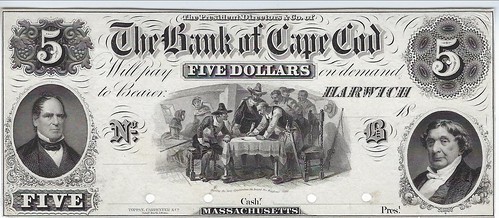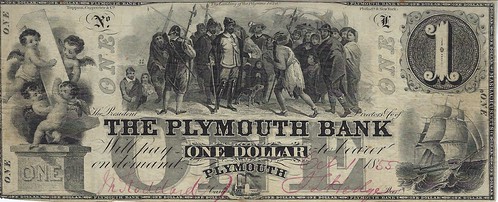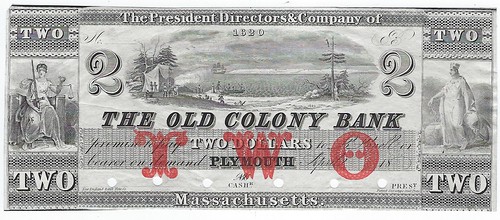
PREV ARTICLE
NEXT ARTICLE
FULL ISSUE
PREV FULL ISSUE
THANKSGIVING VIGNETTESIn the U.S., the Thanksgiving holiday will soon be upon us. John Ferreri kindly submitted this timely article about Thanksgiving vignettes on obsolete paper money. -Editor
In The Name of God, Amen!
An Historic American Event C. John Ferreri On Sept 16th , 1620 a group of 102 men and women set out from Plymouth, England to start a new life in northern Virginia. They came close but actually ended up on the shores of Cape Cod in what would later become, the State of Massachusetts. They were escaping church prosecution and hoped to be able to live by their own beliefs here in this new land. They anchored their ship, the Mayflower, off Provincetown, Massachusetts and made a few day trips to explore the shore to see if it could help sustain them.
While on board and actually
before they proceeded another few miles across the bay to the distant
shore of Plymouth, they drew up, agreed to live by, and signed a
document that became their first constitution which we now know as
the Mayflower Compact. The Mayflower's main cabin became the
study where this
The title of this article is the opening statement of that
A group of the Pilgrims has gathered to meet a representative of a
native tribe of indigenous people. This vignette is a copy of the 1818 painting,
The ship, Mayflower may be seen in the background and Pilgrims coming ashore to join with others readying a tent and preparing food. Note the Pine Tree to the right with a Native American approaching below and an Osprey above, keeping an eye out for errant bits of food. The date, 1620 appears in the sand to the left of the tree on this plate executed by the New England Banknote Company about 1835. The scenes depicted on these three banknotes are of the earliest American historical event captured on some issues of our early paper money, before the advent of federally issued paper money. These have become a text of images and a source of knowledge for those interested in learning about their origin. During this Thanksgiving season it is customary to give thanks for our good fortunes just as the Pilgrims before us and as collectors we could also give thanks for the foresight shown by the early bankers, artists and engravers when executing these historic images. Thanks, given. -Editor
THE BOOK BAZARREWayne Homren, Editor The Numismatic Bibliomania Society is a non-profit organization promoting numismatic literature. See our web site at coinbooks.org. To submit items for publication in The E-Sylum, write to the Editor at this address: whomren@gmail.com To subscribe go to: https://my.binhost.com/lists/listinfo/esylum All Rights Reserved. NBS Home Page Contact the NBS webmaster 
|


